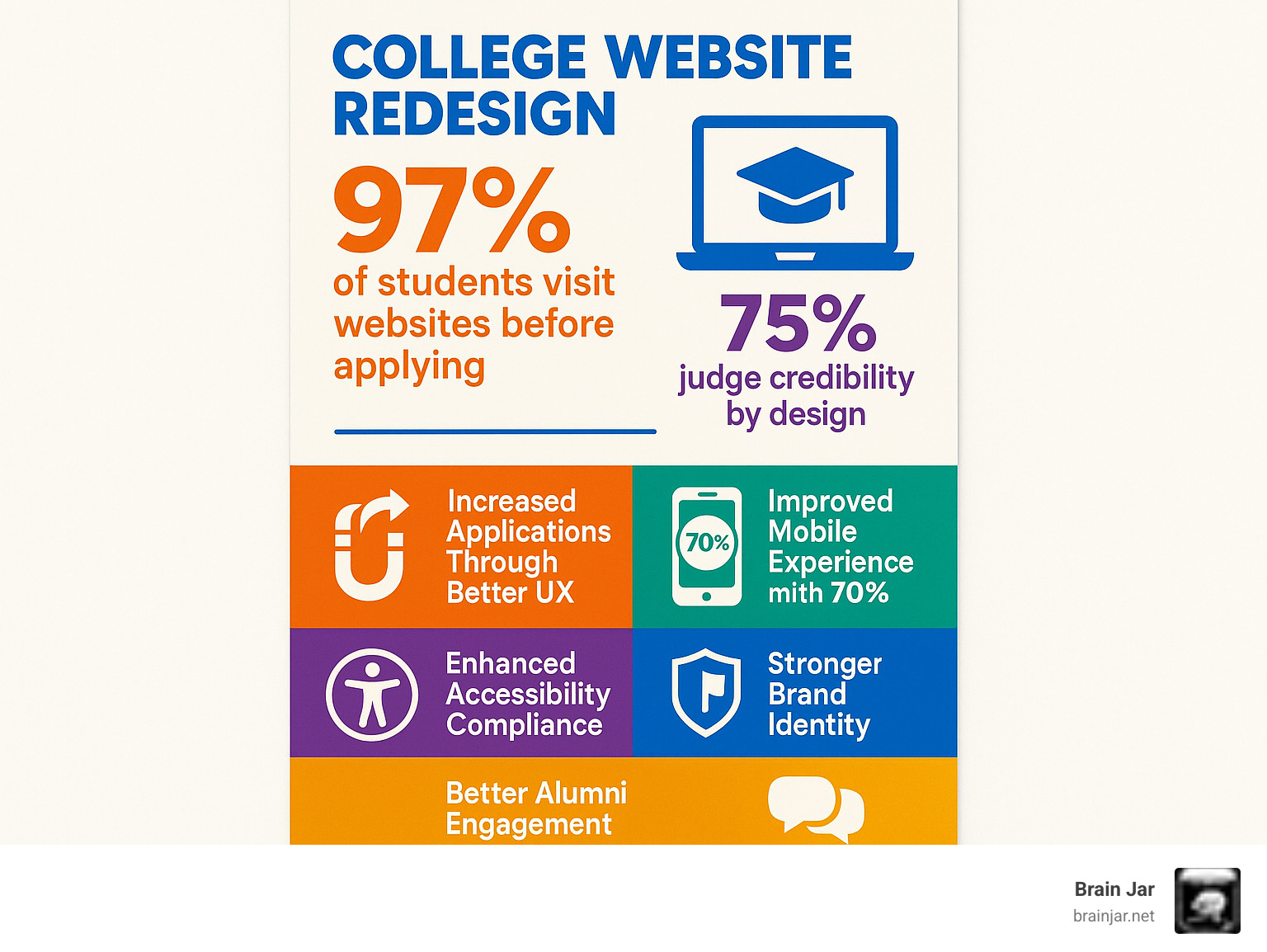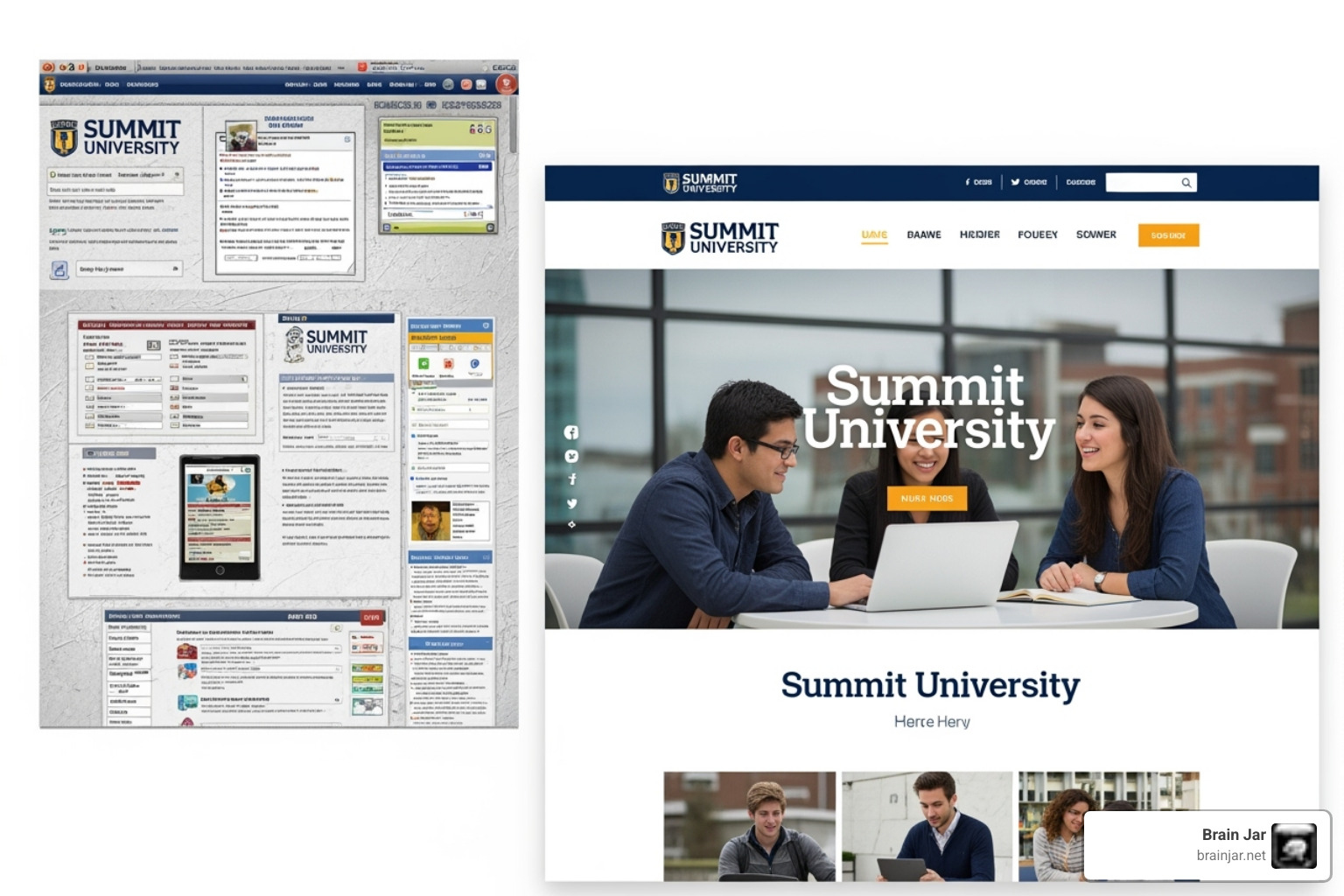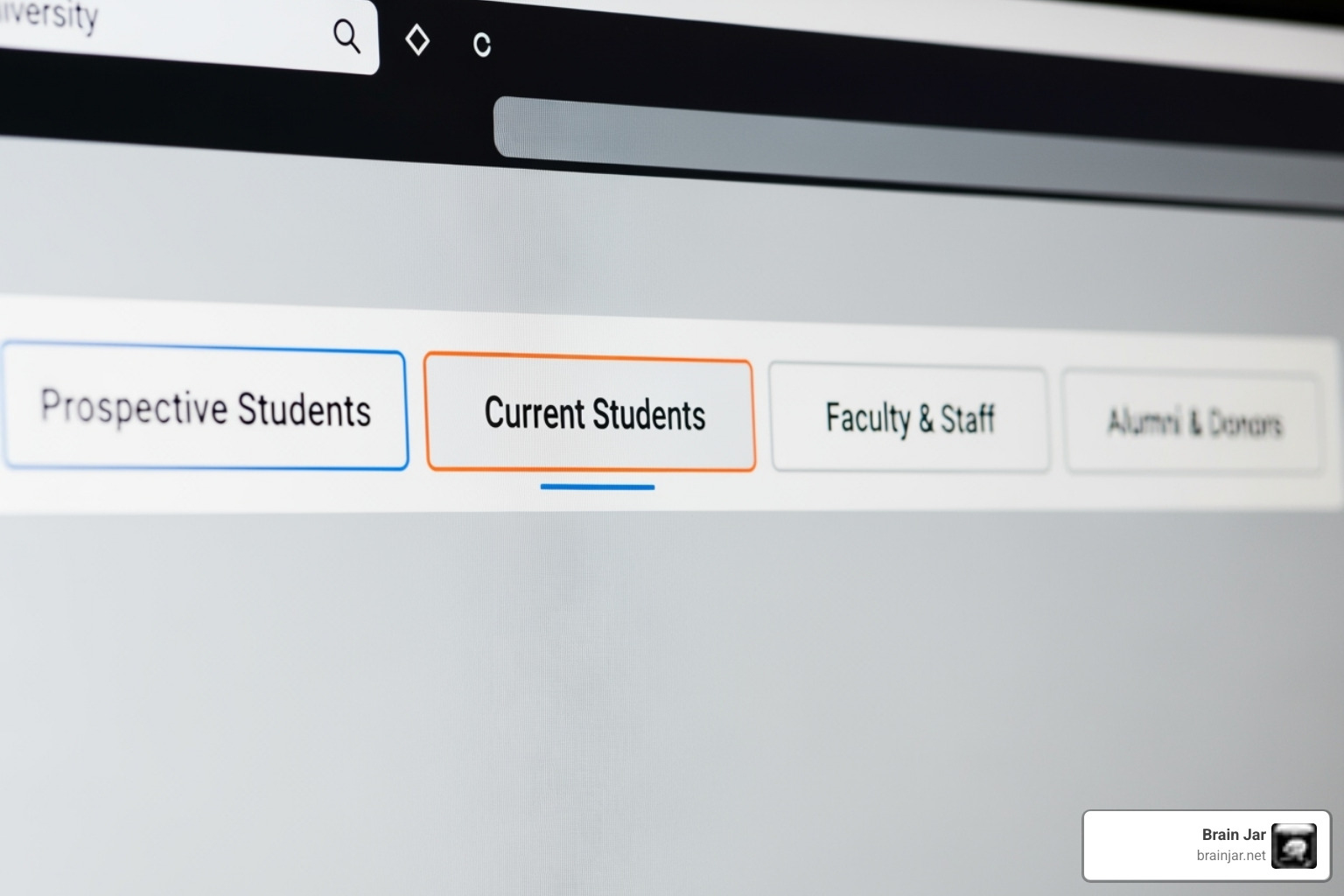Why Your Digital Campus Needs a Strategic Change
A college website redesign modernizes an institution’s digital presence to better serve its entire community, from prospective students to alumni. Here’s what you need to know:
Key Components of a College Website Redesign:
- User Experience (UX) – Creating intuitive navigation and mobile-responsive design
- Brand Alignment – Reflecting institutional mission and values through visual design
- Content Strategy – Developing compelling, accessible content that drives engagement
- SEO Integration – Optimizing for search engines to improve visibility
- Accessibility Compliance – Meeting ADA and WCAG standards for inclusive access
- Performance Optimization – Ensuring fast loading speeds and technical excellence
Your website is your institution’s digital front door. With 97% of prospective students visiting before applying, and forming an opinion in just 0.05 seconds, design quality is crucial for credibility.
An outdated site hurts enrollment and fundraising. Since 75% of users judge credibility on design, a strategic redesign is essential for success.
A well-executed redesign can increase applications, improve engagement, and strengthen your brand in a competitive landscape.
I’m HJ Matthews, Business Development Manager at Brain Jar. With over 15 years of experience, I’ve guided many educational institutions through successful college website redesign projects that drive measurable results.

The ‘Why’: Aligning Your Digital Campus with Institutional Goals
A college website redesign is more than a cosmetic update; it’s a strategic move to transform your most powerful marketing tool into an asset that drives results.
Your website is a 24/7 digital ambassador, recruitment officer, and brand spokesperson. Since 75% of people judge credibility on website design, visitors make split-second decisions about your institution’s quality and reputation based on its appearance.
An outdated or poorly functioning site suggests your institution is behind the timesa damaging message for any college. A strategic redesign aligns your digital presence with your mission, building trust and driving action. It must deliver a compelling, professional experience that reflects your institution’s value to every visitor, anytime.
For a deeper dive into why this change is so critical, check out our comprehensive guide: Why Your College Website Needs a Redesign.
Defining the Primary Goals of a College Website Redesign
A successful redesign starts with clear goals to ensure meaningful outcomes.
- Increasing prospective student applications is a top priority. Since 97% of prospective students visit your site before applying, a modern, intuitive design is crucial for guiding them through their decision-making journey.
- Improving engagement for current students is vital for serving the whole community. Easy access to resources, services, and announcements keeps students engaged and supported.
- Strengthening alumni and donor relations creates lasting connections. Connected alumni are more likely to give back, and effective digital tools can increase repeat donations by 26%.
- Showcasing faculty expertise is important, as 52% of prospective students consider faculty credentials. Your redesign must make it easy to explore faculty achievements and research.
- Reinforcing brand messaging builds a stronger reputation. Consistent messaging across your digital presence creates trust and recognition in a crowded marketplace.
- Streamlining internal communications is crucial for efficiency. Easy access to internal information helps faculty and staff work more effectively.
Reflecting Your Institution’s Brand and Mission
Your website should be a digital extension of your campus, with every element working to tell your unique story.
- Visual identity is more than a logo. It’s a cohesive look reflecting your institution’s personalitybe it traditional, modern, or community-focusedto communicate your core qualities instantly.
- Tone of voice differentiates your institution. Whether formal or conversational, your tone should be consistent and authentic to your brand.
- Storytelling turns facts into compelling narratives. Share stories of student success, faculty breakthroughs, and campus traditions to help prospective students envision themselves as part of your community.
- Showcasing campus culture needs authentic photography and video to capture the energy of your campus. Letting visitors feel your community’s spirit encourages them to join.
- Highlighting unique value propositions means emphasizing what sets you apart, whether it’s innovative research, career services, or a strong alumni network. These unique strengths deserve prominent placement.

The visual change is significant. A cluttered site suggests disorganization, while a clean, modern design communicates professionalism and builds confidence in your institution’s ability to prepare students for the future.
The ‘What’: Core Pillars of a High-Performing University Website
A college website redesign is more than just visuals. A great university website is a high-performing machine that serves every visitor’s needs with precision. Your website is your digital campus quad: welcoming, easy to steer, and functional. Core pillars include user-centric design, a mobile-first approach, intuitive navigation, fast loading speeds, and clear calls-to-action (CTAs).
These elements create an outstanding user experience (UX), which is crucial for higher ed websites where visitors make life-changing decisions. For a deeper dive, read our article on The Importance of User Experience in College Websites.
Enhancing User Experience (UX) for Every Audience
College websites must serve diverse audiences with different needs, from prospective students and faculty to alumni. This diversity is a challenge and an opportunity. A redesign should create segmented user pathways that provide a personalized experience for each visitor.
- Personalized content can range from showing relevant program information based on browsing behavior to providing customized dashboards for logged-in students.
- Intuitive navigation is essential. Main menus should have 5-7 clearly labeled items, avoiding academic jargon to ensure users can easily find what they need.
- With over 70% of college searchers on mobile, your site must be perfectly optimized for smartphones, not just scaled down.
- Sites must load in under 3 seconds. Research shows 38% of people will leave a slow or difficult-to-steer site, losing you potential students.

Ensuring Website Accessibility and Inclusivity
Accessibility is both the right and smart thing to do. It opens your institution to over 61 million U.S. adults with disabilities and is essential for legal protection, with ADA-related lawsuits on the rise.
In a redesign, we follow the Web Content Accessibility Guidelines (WCAG). These ensure content is perceivable, operable, understandable, and robust.
ADA compliance means providing alt text for images, ensuring smooth keyboard navigation, and using high-contrast colors to accommodate all users. Video captions are crucial for accessibility, SEO, and users who watch videos with the sound off.
True inclusivity means showcasing your commitment to diversity, equity, and inclusion (DEI). As students increasingly value diversity, your site should highlight resources, feature diverse stories, and affirm that everyone belongs.
Given the rise in student mental health concerns, a dedicated, easy-to-find section for counseling resources is essential and can be life-changing.
The ‘How’: A Strategic College Website Redesign Process
A college website redesign can feel overwhelming, but like any major project, it requires the right blueprints, team, and a clear vision of success. Successful redesigns follow a structured process including project planning, stakeholder collaboration, content audits, CMS selection, and early SEO integration to create a digital experience that serves your community.
For institutions ready to dive deep into this process, we’ve created a comprehensive resource that walks you through every step: The Ultimate Guide to Higher Ed Website Redesign.
Integrating SEO and Digital Marketing from Day One
A beautiful website is useless if prospective students can’t find it. Since 93% of online experiences begin with a search engine, SEO is essential for visibility. SEO must be integrated from day one, starting with keyword research for programs to understand how students search.
- On-page SEO for academic pages is crucial. Every academic page needs compelling titles and meta descriptions that naturally incorporate relevant keywords for both users and search engines.
- A technical SEO audit ensures your site is fast, mobile-friendly, and uses structured data so search engines can understand your content.
- Local SEO for campus location is important as many students search by location. Your redesign should clearly highlight your campus location and its unique features.
- Paid ad campaigns offer immediate impact. With 63% of prospective students clicking on college ads, paid campaigns are effective. This includes leveraging Google Ad Grants for eligible institutions.
Developing a Winning Content and Multimedia Strategy
Content is the soul of your website. A successful redesign pairs great design with content that connects with your audience and tells your institution’s story.
- A content audit and governance plan is the first step. We review existing content to decide what to keep, update, or remove, and establish governance to keep content fresh and accurate post-launch.
- Storytelling through student testimonials brings your institution to life. Real student experiences provide social proof and help prospective students imagine themselves as part of your community.
- High-quality photography conveys the personality and energy of your campus. With 94% of first impressions related to visual design, authentic, high-resolution photography is a critical investment.
- Video content is essential. With 82% of prospective students watching videos on college sites, it’s no longer optional. Use videos for campus tours, student vlogs, and faculty interviews to increase time on site and boost conversions.
- Interactive elements transform browsing into exploration. Virtual tours are used by 73% of students before contacting admissions. Cost calculators and interactive timelines also add significant value.
Navigating Challenges and Measuring ROI
A college website redesign has its challenges, but with a solid game plan, every obstacle has a solution. Knowing what to expect is key.
Budget constraints are a common concern. We help you prioritize features and can create a phased approach to deliver the biggest impact first, making the most of a tight budget.
Managing stakeholder feedback from various departments can be challenging. The key is establishing clear communication channels and a designated decision-maker. For more guidance, read our article on How to Choose the Right Web Design Company for Your College.
Content migration can feel overwhelming, but it’s an opportunity to audit your content, keeping only what serves your audience. Technical problems and scope creep are also common, requiring an experienced team and clear project boundaries from the start.
Overcoming Common Redesign Obstacles
Success requires smart planning. Establish a core project team with clear roles and decision-making authority. A phased rollout approach can help manage budgets and stakeholder concerns. Clear communication plans with regular updates and transparent timelines are essential for managing expectations. A flexible CMS is crucial for long-term success, allowing your site to evolve. Finally, partnering with an experienced agency provides the expertise to steer any challenges.
Measuring the Success of Your College Website Redesign
A well-executed college website redesign doesn’t just look better; it performs better, delivering measurable improvements that impact your mission. We track performance using tools like Google Analytics 4, establishing baselines before launch to measure progress accurately.
| Metric | Before Redesign (Average) | After Redesign (Target) |
|---|---|---|
| Bounce Rate | 52% | <35% |
| Application Submissions | Baseline | Increase by 15-30% |
| RFI Form Submissions | Baseline | Increase by 20-40% |
| Virtual Tour Engagement | Baseline | Increase by 25-50% |
| Time on Page (Avg.) | 1:30 min | 2:30 min + |
| Mobile Conversion Rate | Baseline | Increase by 10-20% |
Key metrics to track include:
- Application and RFI Form Submissions: These directly translate to enrollment potential.
- Virtual Tour Engagement: Higher interaction rates show students are connecting with your campus.
- Time on Page: Longer visit durations indicate genuine interest in your programs.
- Bounce Rate Reduction: A lower bounce rate (we aim for under 35% from the average 52%) means more visitors are staying to explore your site.
We provide continuous monitoring to identify trends and make data-driven recommendations for ongoing improvements, ensuring your website evolves to better serve your community.
For real-world examples of how these improvements translate to institutional success, take a look at our Case Study: College Website Redesign Success.
Frequently Asked Questions about College Website Redesigns
Starting on a college website redesign can feel overwhelming. It’s a significant investment that impacts your entire digital presence. Here are answers to the most common questions we receive to help you move forward with confidence.
How long does a college website redesign typically take?
A comprehensive college website redesign typically takes 6 to 12 months. This timeline reflects the complexity of creating a powerful digital tool meant to serve your institution for years. The timeline depends on project scope and resource availability. A smaller college with a dedicated team will move faster than a large university with complex needs.
A typical project breaks down into four phases:
- Planning and Strategy (1-3 months): Defining goals, auditing content, and mapping the user experience.
- Design and Development (3-6 months): Creating the visual design and technical implementation.
- Content Migration and Testing (1-3 months): Moving content and testing across all devices.
- Launch and Optimization: Going live and continuously improving performance.
While some projects can be completed in four months, large universities with complex needs may require up to 18 months.
Who should be on the website redesign team?
Building the right team is critical for success. The most effective teams are cross-functional, representing the diverse needs of your institution. Your team should include:
- Marketing and Communications: To lead brand and messaging strategy.
- IT Department: For technical expertise, integrations, and security.
- Admissions Office: To provide insights on prospective students.
- Faculty and Student Representatives: To ensure academic accuracy and user-centric design.
- Alumni and Development: To guide fundraising and engagement features.
- Executive Sponsor: To make final decisions and remove obstacles.
Effective collaboration between these stakeholders is the key to a successful project.
How much does a college website redesign cost?
This is a common question, but the cost of a college website redesign varies widely based on your institution’s specific needs. Costs are influenced by several factors:
- Institution Size and Complexity: A large research university has more complex needs than a small liberal arts college.
- Custom Features: Custom interactive elements and third-party integrations increase costs.
- In-House vs. Agency: Agency partnerships can be more efficient, offering long-term value.
- CMS Licensing Fees: Costs vary depending on the chosen platform.
- Content Creation: New photography, video, and copywriting are additional investments.
- Ongoing Maintenance: Your site will need continuous support to remain secure and effective.
Costs can range from tens of thousands to several hundred thousand dollars. We work with each institution to prioritize features that deliver the biggest impact within their budget. View this as a strategic investment, not an expense. A successful redesign pays for itself through increased applications, donor engagement, and an improved institutional reputation.
Conclusion
Your website is the digital heartbeat of your campus. A strategic college website redesign is one of the most impactful investments you can make in your institution’s future.
With 97% of prospective students visiting your site before applying and forming an opinion in seconds, your digital presence shapes your enrollment pipeline. The stakes and potential rewards are equally high.
Successful redesigns are built on user-centric experiences, authentic brand reflection, and a solid technical foundation of mobile responsiveness, accessibility, and SEO. While challenges like budget constraints and stakeholder management exist, institutions that steer them with clear goals and experienced partners see remarkable results. Increased applications, better engagement, and stronger alumni connections are typical outcomes.
A redesigned website becomes a living extension of your campus, capturing its energy and creating genuine connections. In a digital-first world, this is essential.

A redesigned website is more than a faceliftit’s a powerful engine for growth, engagement, and institutional success. For institutions ready to transform their digital campus, the expert team at Brain Jar provides comprehensive web development and marketing strategies to achieve your goals. Explore our services to get started.

